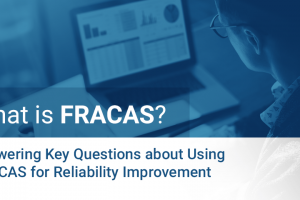This article is an excerpt from our “An Overview of Reliability Analysis Tools and Techniques” white paper.
Reliability analysis is often used as a broad term for a range of analyses used to evaluate and improve the quality of products, processes, and systems. While the term “reliability” can apply in a general sense to the overall performance of a product or system, in engineering disciplines, reliability is a specific metric that can be quantitatively assessed. Engineers sometimes use the term RAMS analysis as a more encompassing term for all the techniques used to analyze and improve products and processes.
What is RAMS Analysis?
RAMS analysis is a well-established approach for evaluating four critical factors related to system performance: reliability, availability, maintainability, and safety. Widely used in engineering disciplines, RAMS analysis ensures that systems meet operational requirements throughout the lifecycle. The objective of RAMS analysis is to assess reliability, availability, maintainability, and safety in an organized way, identify areas of concern, and facilitate improvements to ensure that program goals are met.
Organizations may not focus on all four elements but may focus on a specific combination crucial for their particular situation. Additionally, these four elements may be prioritized in different ways depending on the unique requirements for varying market sectors. For example, in some industries risk levels may be a compliance factor, while in other industries reliability or MTBF analysis is a contractual requirement. The use of the term RAMS allows for encompassing all these related activities under one umbrella.
What is Reliability?
Reliability is defined as the probability, or likelihood, that an item will perform a desired function without failure under stated conditions for a stated period of time. In general, reliability is an indicator of the likelihood a product will operate without failure.
Reliability is one of the most critical aspects of product design and development. It is why reliability engineering plays a key role in the engineering field, and why there are a wealth of tools and techniques available to assess and evaluate product reliability throughout the lifecycle.
Reliability Analysis Tool Example: Reliability Prediction
Reliability Prediction analysis is one of the most widely used tools in RAMS analysis. The core function is to evaluate an electro-mechanical system and, based on its parts and their associated operating and rated parameters, to estimate or predict its failure rate or MTBF.
Reliability Predictions are performed using a prediction standard, or a document which delineates the methods and equations used to quantify reliability. Some example standards include MIL-HDBK-217, Telcordia, 217Plus, IEC 61709, SN 29500, and ANSI VITA.
Depending upon your particular needs, one standard maybe more applicable, or you may even use a combination of standards. Our in-depth guide on reliability prediction standards provides detailed information. These widely accepted prediction standards have been developed over years of research. Using statistical analysis over a huge range of historical device data, the equations defined in the standards represent a solid basis for reliability estimates.
Reliability Prediction analysis tools are often augmented with an abundance of features that enhance and advance reliability analysis. These include:
- Component part databases for automated retrieval of device parameters
- Derating analysis for evaluating device overstressed conditions
- Mission profiling for assessing reliability over a defined mission
- Allocation analysis for determining the optimum allocation of failure rates over a system
- What-If? analyses for performing design trade-off studies
Learn More about Reliability Analysis Tools and Techniques
“An Overview of Reliability Analysis Tools and Techniques” covers the following topics:
- What is RAMS Analysis?
- What is Reliability?
- What is Availability?
- What is Maintainability?
- What is Safety?
- How is RAMS Analysis Done?
- Reliability Analysis Tools
- Reliability Prediction
- FRACAS
- Weibull Analysis
- ALT Analysis
- Additional Tool for Reliability Analysis
- Availability Analysis
- RBD
- Additional Tools for Availability Analysis
- Maintainability Analysis
- Maintainability Prediction
- RCM
- Additional Tools for Maintainability Analysis
- Safety and Risk Analysis
- FMEA
- Fault Tree Analysis
- Additional Tools for Safety Analysis
- Benefits of Using Multiple Tools
- Reliability Analysis Tools
- Conclusion
Download the full white paper here. If you are interested in learning more about Relyence software, contact us or start your free trial today!




